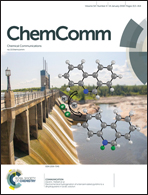Ligand-induced decarbonylation in diphosphine-ligated palladium acetates [CH3CO2Pd((PR2)2CH2)]+ (R = Me and Ph)†
Abstract
A new decarbonylation reaction is observed for [(K2-acetate)Pd(K2-diphosphine)]+ complexes. Gas-phase IR experiments identify the product as [CH3Pd(OP(Ph2)CH2PPh2)]+. DFT calculations uncovered a plausible mechanism involving O atom abstraction by the diphosphine ligand within the coordination sphere to yield the acetyl complex, [CH3COPd(OP(Ph2)CH2PPh2)]+, which then undergoes decarbonylation.
![Graphical abstract: Ligand-induced decarbonylation in diphosphine-ligated palladium acetates [CH3CO2Pd((PR2)2CH2)]+ (R = Me and Ph)](/en/Image/Get?imageInfo.ImageType=GA&imageInfo.ImageIdentifier.ManuscriptID=C7CC08944A&imageInfo.ImageIdentifier.Year=2018)


 Please wait while we load your content...
Please wait while we load your content...